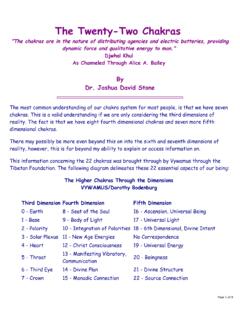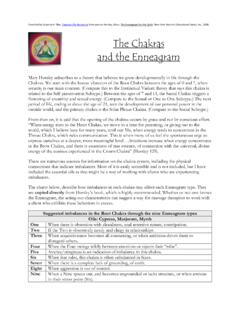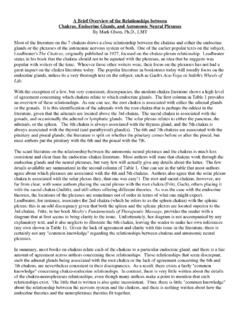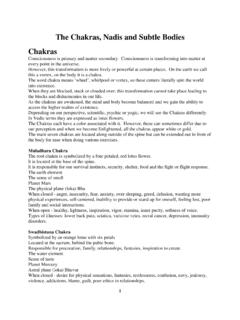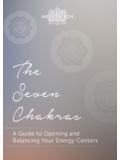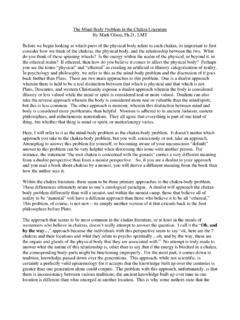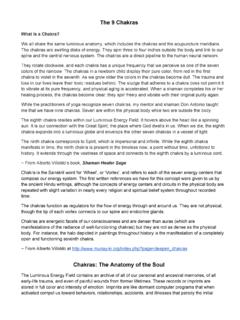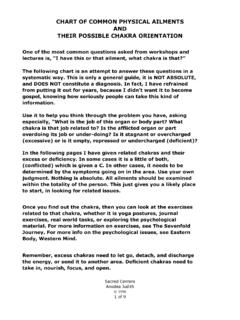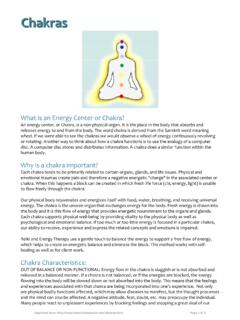Transcription of Mayan yoga: Chakras and Energy in Ancient Middle America ...
1 Stela 1, Tikal Museum, Guatemala Mayan yoga : Chakras and Energy in Ancient Middle America By Lee van Laer and Richard Lloyd Introduction One of the more astonishing facts regarding Ancient civilizations is how their religious symbology and architecture seem to imply a synchronistic source of higher inspiration. Without modern electricity and technologies, the ancients lived in intimate proximity to a natural world which seemed saturated with various underlying laws. Religion, government, and philosophy were not separate entities, but a single interpretive syllogism. Connections between architectural styles, symbolic lexicons, and myths of the creation abound, crossing geographic territories in such a way as to imply widespread connections between even very Ancient peoples.
2 In the New World, satellite imagery has shown that in the jungles of the Yucat n and between North and South America , there are hundreds of yet unexcavated buildings, sacred and otherwise, hidden within the overgrown jungles. These cultures supposedly evolved in complete separation from the old world, yet in introspection into the structure of the human organism, the Mesoamerican cultures and the Hindu, Tibetan, and Chinese yogas and medical systems appear, to the trained eye, to find an unexpected common ground. One such Mayan stela is the object of this paper. This artifact bears a close resemblance to pictograms or ideograms such as one finds in Yogic or Chinese medicinal representations of the inner bodies, which are purported to reveal an almost unbelievable potential in man.
3 Although the genealogy of the Mayan people is not completely clear, some scholarly thinking speculates on the possibility of the arrival of some Mesoamerican peoples to long sea voyages from Polynesia, China, Japan and India proper. If this theorem is correct, then the precursors to Mayan civlization may have brought with them a far eastern cultural heritage regarding the inner structure of man. The stela in question decidedly points to a medical point of view in alignment with Eastern schools of medical thought; those medical concepts which are shared throughout India, China, Korea, Japan and Hawaii, as in yoga , Laya, Tantra, Hatha and Huna. One of the signature facts of Ancient civilizations is that they consistently used religious imagery in their public buildings.
4 A great deal of the material one finds in Ancient cultures relates to religious practice of one kind or another, yet it might be said that archaeologists on the whole have little practical experience and no great expertise in esoteric religious practice, which is consistently depicted in the iconography of many Ancient cultures. A lack of expertise in esoteric religious and medical practices of the far east have caused archaeologists to for the most part overlook these soterological (salvation-related) emblems and symbols. This deficiency may also cause them to fail to recognize the significance of certain images which were meant to be spiritual teaching diagrams, or what Gurdjieff would have called legominisms records of important truths.
5 Because the Ancient Mesoamericans were separated from old world cultures by two vast stretches of ocean, it's presumed that their religious practices and cosmologies evolved independent of old world understanding. Some scant evidence of contacts between new and old world cultures has emerged over the past 20 years or so, notably the discovery of cocaine in the hair of Egyptian mummies, and some very distinctive central American papermaking techniques whose only other known parallel is found in Polynesia, but for the large part we assume these cultures were separated and that their ideas were unique and independent. The Mayans, however, developed whether on their own or under some as yet unidentified old world influence a set of mythological beliefs remarkably similar, in some ways, to other cultures in the old world.
6 The widespread use of the serpent God Quetzalcoatl, for example, is mirrored in the extensive use of serpent imagery at Angkor Wat, and most especially in Kundalini yoga proper. We propose that the similarity is not coincidental. Hence a brief outline of Kundalini yogic practices may be in order. The serpent is, in mythology, considered as the most intelligence of the creatures of the creation. In Hindu myth, a serpent is used to churn the waters of life and separate the milk from the bad , a poison which is then rendered harmless by being swallowed by the God Shiva, which turns his throat blue. In the Greek tradition, a firmly Western tradition, two intertwined serpents are used to represent the medical caste in the caduceus.
7 These two serpents are, in esoteric tradition, said to represent the three main Nadis of yogic thought: the staff representing the Spinal column, which is the Sussumna and the right and left crossing at the Chakras (wheels-centers) as the Pingala (active Yang, sunlight, male ) and Ida ( Yin, right brain imagery, feminine, passive, relaxing and calming.) At the top are two wings which represent the "Command center" or Ajna Charkra. In the Middle of the spine are said to be three wrappings , together called the Sushumna, representing balance, light, and containing an opening at the bottom which is blocked by the nose of the snake called the Kundalini, who is wrapped 3 times around the base of the Sushumna and sleeps.
8 Her dreams are referred to as the actual phenomenological world which we mis-identify with. The Kundalini Scriptures state: For he who knows, Kundalini is a blessing; for he who doth not know, She is a curse. The esoteric object of Hatha yoga is liberation from Kundalini, as opposed to a set of exercises to limber and relax the human body. Hatha, which means violent or forced against the Will, is designed to suffocate or shock or otherwise strike the sleeping Kundalini into wakefulness, whereupon She is said to straighten up as a cobra might, and surge up the Citrini (the smallest central opening in the Sushumna), causing each chakra to cease in its spinning, pierce the three Granthi (knots of mis-identification) and join her Husband/Lover Lord Shiva in reams of never-ending untold bliss.
9 This is the end result sought after by true Yogis world over, even if they don t know it. It is said to be an extremely dangerous practice, easily leading with one mistake to death or insanity. The traditions report that inhabitations by demonic possessions may also occur if even one step is wrongly misguided. The very complex world of Mayan gods, many with demonic aspects, and fraught with dangers, seems to mirror these traditions, and finds parallels in traditional Tibetan and Hindu iconography, both of which have all of their roots in Tantric disciplines. This encoded form of knowledge was likely secretive and for the few who could read the Stela. In the West we are told about a seventh chakra called the Sahasara a Sanskrit word which simply means one thousand, and is shown as a paricap of Lotus flowers hanging over the head.
10 This center is actually not in the body , but above it, which is why the translation of the Six chakra Tantra" in The Serpent Power by Sir John Windroff is properly translated as a six, and not seven, centered tantra. The Meso-American cultures used the symbol of the serpent in the same way that the Ancient Hindu and Buddhist cultures did to depict and describe the movement of yogic Energy , or spinal Energy , through the human body. Much of their iconography, properly understood, suggests this; Mayan stelae and artworks embody esoteric principles that students of Tantric diagrams and the Chakras will find very familiar. By Tantric, we mean doctrines and principles involving mantras, meditation, yoga , ritual, and most particularly what is referred to in the old world as kundalini yoga .
